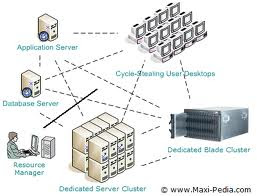DISTRIBUTED
COMPUTING
What is distributed computing?
- A distributed computer system consists of multiple software components that are on multiple computers, but run as a single system.
- The computers that are in a distributed system can be physically close together and connected by a local network, or they can be geographically distant and connected by a wide area network.
- A distributed system can consist of any number of possible configurations, such as mainframes, personal computers, workstations, minicomputers, and so on.
- The goal of distributed computing is to make such a network work as a single computer.
Distributed systems offer many benefits over centralized systems, including the following:
Scalability
The system can easily be expanded by
adding more machines as needed.
Redundancy
Several machines can provide the same
services, so if one is unavailable, work does not stop.
- Additionally, because many smaller machines can be used, this redundancy does not need to be prohibitively expensive.
- Distributed computing systems can run on hardware that is provided by many vendors, and can use a variety of standards-based software components.
- Such systems are independent of the underlying software.
- They can run on various operating systems, and can use various communications protocols.
- Some hardware might use UNIX(R) as the operating system, while other hardware might use Windows operating systems.
- For intermachine communications, this hardware can use SNA or TCP/IP on Ethernet or Token Ring.
- The following figure is an example of such a distributed system.
- This system contains two local area networks (LANs) that are connected to each other.
- One LAN consists of UNIX workstations from several different manufacturers; the other LAN consists primarily of PCs that are running several different PC operating systems.
- One of the LANs is also connected to a mainframe by way of an SNA connection.
The client/server model
- A common way of organizing software to run on distributed systems is to separate functions into two parts: clients and servers.
- A client is a program that uses services that other programs provide.
- The programs that provide the services are called servers.
- The client makes a request for a service, and a server performs that service.
- Server functions often require some resource management, in which a server synchronizes and manages access to the resource, and responds to client requests with either data or status information.
- Client programs typically handle user interactions and often request data or initiate some data modification on behalf of a user.
- For example, a client can provide a form onto which a user (a person working at a data entry terminal, for example) can enter orders for a product.
- The client sends this order information to the server, which checks the product database and performs tasks that are needed for billing and shipping.
- Typically, multiple clients use a single server. For example, dozens or hundreds of clients can interact with a few servers that control database access.
- The client is isolated from the need to know anything about the actual resource manager.
- If you change the database that you are using, the server possibly needs to be modified, but the client does not need to be modified.
- Because usually fewer copies exist of the server than of the client, and because the servers are often in locations that are easier to update, the update procedure is also simplified.
- Also, this approach provides additional security.
- Only the servers, not the clients, need access to the data that the resource manager controls.
- Clients can also access several different servers, and the servers themselves can act as clients to other servers.
- Exactly how the functions are distributed across servers is an application design decision.
- For example, a single server could provide all the services that a client needs, or the client could access multiple servers to perform different requests.
- The application designer must consider items such as scalability, location, and security.
- Some servers are part of an application and are referred to as application servers. Other servers are not part of a specific application. Instead, any application can use them.
- For example, the CICS Structured File Server (SFS) provides record-oriented file access for applications.
Three-tiered
client/server architecture
A common design of client/server systems
uses three tiers:
1.
A client that interacts with the user
2.
An application server that contains the business logic of the
application
3.
A resource manager that stores data



No comments:
Post a Comment